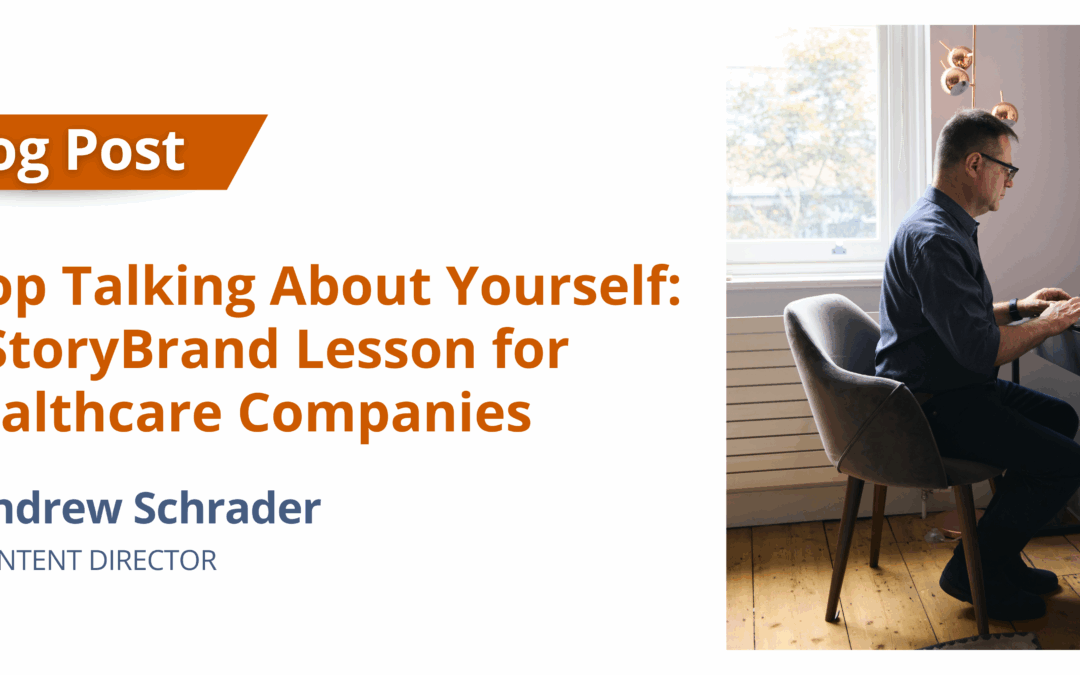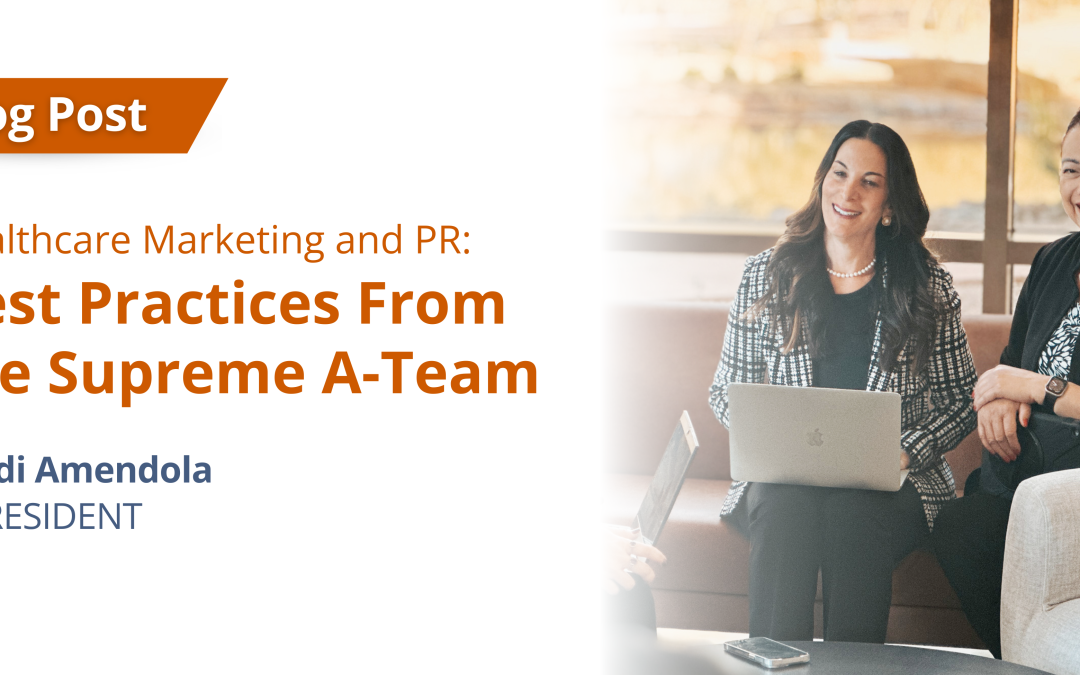
by Andrew Schrader | Oct 1, 2025 | Blog
For over ten years I’ve helped healthcare, health tech, and life sciences companies clarify their messaging and get their customers to listen. And time after time, I’ve seen the same thing happen.
Companies fall in love with their own features and benefits.
It’s understandable — they’ve worked hard to build them. But here’s the problem: features and benefits aren’t a story. They don’t create stakes. And without stakes, no one cares.
The “Hero” Mistake
Let’s take a fictional example. Meet Acme Revenue Solutions, a company in the revenue cycle management (RCM) space. Here’s how they might describe themselves:
“Acme Revenue Solutions helps hospitals streamline billing, reduce claim denials, and accelerate reimbursements. Our platform uses AI-driven automation to handle coding, compliance, and collections. With Acme, you can save time, lower costs, and maximize revenue.”
Not bad, right? In fact, it’s how many healthcare companies present themselves. It lists the features, highlights the benefits, and checks the right boxes.
The problem is, it’s also forgettable.
Why? Because Acme is playing the hero, talking about their own superpowers. Meanwhile, the customer — the hospital CFO, the director of revenue cycle, the VP of finance — is left as a spectator in their own story.
And here’s the thing: your customer is not looking for a hero.
Your customer is the hero. You are the guide.
When you forget that, they tune out.
Enter StoryBrand
Six years ago, I had the chance to attend a three-day StoryBrand workshop, and it completely changed the way I thought about messaging. If you haven’t heard of it, StoryBrand is a simple, seven-step storytelling framework developed by Donald Miller. It helps companies stop confusing their audience and start clarifying what they actually offer.
The framework boils down to this:
- A Character — your customer.
- Has a Problem — the thing that keeps them up at night.
- And Meets a Guide — that’s you.
- Who Gives Them a Plan — a simple, clear path forward.
- And Calls Them to Action — tell them what to do.
- That Ends in Success — paint the picture of the win.
- And Helps Them Avoid Failure — don’t skip the consequences.
In this framework, the customer is always the hero. You’re the guide.
The reason so much marketing feels flat is because it’s upside-down. Instead of putting the customer at the center of the story, companies hog the spotlight.
That’s why I like to bring in another concept — stakes. When you define what the customer stands to gain or lose, you put urgency and meaning back into the story. And that’s what makes StoryBrand so powerful.
Reframing With Stakes
So how do we make Acme’s message actually matter? We switch the lens. Instead of rattling off features and benefits, we frame the stakes — what the customer stands to gain or lose.
Here’s a rewrite, StoryBrand-style:
“Every day a claim is denied, hospitals lose critical revenue that should be funding patient care. Billing teams are overwhelmed, clinicians are frustrated, and patients get caught in the middle. It doesn’t have to be this way.
Acme Revenue Solutions gives your hospital the clarity and control to stop revenue leakage before it happens. With automated claim scrubbing, real-time alerts, and expert support, you can finally focus on care instead of paperwork. Hospitals should be thriving, not drowning in denials. We’ll help you get paid what you’ve earned — so you can put resources where they belong: in patient care.”
Notice the difference?
- External stakes: Denied claims, lost revenue, overworked staff.
- Internal stakes: The frustration of “drowning in denials” and the relief of “finally focusing on care.”
- Philosophical stakes: The belief that hospitals should be thriving and resources should support patient care.
Now, the customer is the hero. They’re the one solving the problem and reclaiming their story. Acme’s role? The guide who gives them the plan and the tools to succeed.
How Writers Make the Switch
When I write for clients, this is the mental shift I’m making. If I catch myself listing features, I stop and ask:
- What’s really at stake for the customer?
- What happens if they don’t solve this problem?
- How will they feel if they do?
- What’s the bigger “should” at play here?
That’s when the copy comes alive. That’s when it stops sounding like every other vendor in the healthcare space. And that’s when customers lean in — because they see themselves in the story.
One other thing: every company truly is unique. Most of the time, that uniqueness is baked into the reason the company exists in the first place — a founder who was fed up with the status quo, a team who saw a better way, or a conviction that something in healthcare just shouldn’t be this hard.
The trouble is, those origin stories often get buried under layers of jargon. My job as a writer is to dig them out and bring them forward. Because yes, two companies might sound alike on the surface — but they aren’t alike. And those distinctions are part of the stakes. They show what’s broken in the world, and why the company exists to fix it.
That’s where the most compelling stories live.
The Bottom Line
If you want your marketing messaging to land, stop trying to be Luke Skywalker. Be Yoda. Be Obi-Wan. Help your customer win their fight.
Because at the end of the day, they don’t want to hear about your features. They want to know what’s at stake — and how you’ll guide them to success.

by Chris Nerney | May 28, 2025 | Blog
Some health technology entrepreneurs are absolutely convinced their company has a unique, revolutionary solution that will transform healthcare. And they will not hesitate to tell you!
Most, however, are more grounded. They only have to look around to see that the problems their solution is designed to solve – whether it’s clinical data quality, patient identity, billing accuracy, etc. – have attracted the interest of other clever and well-intentioned people. They have competition! Worse, some of these sector rivals are well-funded.
Which doesn’t mean your solution is any less genuinely transformative to healthcare consumers, providers, payers, or researchers. What it does mean is you likely face a formidable challenge in rising above the noise in your sector to attract and capture the attention of potential customers and investors. After all, there are a lot of stories being told out there.
So how can healthcare PR and marketing pros make their company’s story compelling enough to break through and stand out in a crowded market? For starters, health tech companies can gain a market advantage by clearly articulating (and repeating) across multiple channels what problems their solutions solve and how these solutions benefit patients. Why should customers choose your solution and not a competitor’s? You need a great answer to that question.
Hone your marketing language to highlight your company’s competitive differentiators. Once you’ve locked in on a framework for your messaging, you can deploy several specific techniques to help your health tech company rise above the clamoring masses. These include:
Practice precision marketing
The marketing messages that resonate with potential customers such as provider organizations or payers may not resonate with investors. While a hospital or health plan will want to know what your technology costs and how it would help them improve care quality or operational efficiency, they’re not interested in a graphic showing the projected growth of your startup’s market sector. Investors, on the other hand, care deeply about a sector’s growth potential as well as a prospective portfolio company’s strengths and weaknesses (particularly its technology and leadership team) relative to the competition.
It is essential that you learn the needs and pain points of each target audience and then tailor a message that specifically addresses them. Try to get feedback from members of your target audience (or people who understand their concerns and priorities) and then modify as necessary.
Go multimedia
We may be in the technology business, but humanity sells. The human connection is a powerful thing; people like to hear and see other people talk. That’s one of the reasons why podcasts have become so popular. If there is someone in your company who could shine on a podcast, do not hesitate to get that person some training and some bookings.
No matter how nervous your subject matter expert may be, once they see the positive response internally and externally, they’ll be pestering you for more podcast opportunities. Then they’ll ask for help getting an agent.
You also can use multimedia in social media and in press releases. Spice up your messaging with pictures, graphics, and even short videos. You won’t need to hire a crew for a three-camera shoot, either; videos can easily be recorded on a smartphone.
Get customers to tell their story
I know, it’s one of the hardest things in marketing. A health tech company’s customers – whether they’re a hospital, health system, payer, or academic center – may not want to get involved in your marketing efforts because 1) they’re pretty busy doing their own jobs, and 2) they worry about being perceived as shills for a vendor. From their perspective, those aren’t unreasonable concerns.
But you won’t know what your customers say until you ask. Suggest doing a white paper on their experiences with your solution or ask for one of their spokespeople to join you on stage at an industry conference or for a podcast. People like to talk about their successes and impart advice to colleagues. It’s all upside to them.
One great selling point for healthcare marketing and PR pros who are trying to get a customer to share their experiences is to emphasize that the customer’s story (and yours) centers around how they were able to better serve patients using your technology, not the merits of the technology itself (which should be apparent in the telling of the story). Again, it’s an opportunity for the customer to talk about what they’re doing to help patients, research, or efforts to control healthcare costs.
Conclusion
To succeed in highly competitive markets, health tech vendors need a coherent message centered around how their solution benefits both patients and potential customers. By tailoring these messages to targeted audiences, leveraging the power of multimedia to build human connections, and working with customers to communicate powerful success stories, health tech vendors truly can stand out in a crowded market.

by Janet Mordecai | Apr 16, 2025 | Blog
Healthcare is complicated and constantly evolving. From navigating strict regulations to addressing diverse stakeholders, healthcare sales teams operate in an increasingly competitive and nuanced environment. Fortunately, marketing teams can play an essential role in amplifying and supporting sales efforts and ensuring sales teams have the tool kit required to deliver success. Working hand-in-glove with sales, marketing can help build cohesive and persuasive messaging, comply with regulatory requirements, and support lead generation with strategically crafted content and campaigns designed to capture the attention of target audiences, nurture their interest, and encourage them to take specific actions.
The Healthcare Sales Landscape
It’s no surprise that healthcare sales teams, in particular, face challenges directly related to the diversity of their target audiences, ranging from hospitals to health plan CEOs to clinicians and patients. Each stakeholder has unique priorities and pain points that must be addressed with a tailored solution or call to action. It’s also true that the U.S. healthcare industry is subject to strict regulations, such as HIPAA, which makes compliance a crucial factor in sales and marketing strategies. Marketing teams can help lay a solid foundation that builds trust, and bolsters thought leadership with clients, prospects, and patients.
Generating High-Quality Leads
In my decades of experience in marketing, lead generation is a crucial focus for sales/marketing collaborations – after all, it’s the core of business growth. Leads drive sales opportunities, boost revenue, and increase brand awareness, and it’s one of the main activities in which marketing can support sales objectives. Without compelling and engaging content, sales can’t drive to the bottom of the funnel. That’s where marketing comes in. A healthcare marketing team can create a white paper on the benefits of a new diagnostic tool or host a webinar on improving patient outcomes through innovative technology.
By providing valuable insights and thought leadership, marketing teams capture leads and position their organization as an industry authority. This establishes credibility and trust, making it easier for sales teams to initiate conversations and close deals.
Equipping Sales Teams with Enablement Tools
Marketing’s role, however, doesn’t stop with lead generation – it can and should move into building an integrated strategy and tactics that provide sales teams with the “enablement” tools and resources to convert leads into clients. These resources may include:
- Sales Collateral: Brochures and product guides tailored to the needs of different stakeholders.
- Pitch Decks: Customizable presentations highlighting key product or service benefits.
- Battle Cards: One-page documents comparing your product or service to competitors that help sales address objections and highlight key differentiators.
- Customer Personas: Detailed profiles of target buyers, including pain points, motivations, and preferred communication styles. These guide sales teams in personalizing their outreach.
- Whitepapers or eBooks: High-value content pieces that establish thought leadership and can be shared with leads to nurture trust and demonstrate expertise.
By creating resources that align and support the sales team’s objectives, marketing can help ensure that every interaction with potential clients is meaningful and impactful.
Creating a Cohesive Narrative
Building and implementing consistent messaging is crucial for sales and marketing, serving as a strong foundation for engagement and customer loyalty. This is especially true in today’s healthcare environment, where trust and credibility are paramount to growth and sustainability. Here again, marketing teams can play a vital role in creating a cohesive narrative that aligns with the organization’s mission and values. Marketing can also help weave this cohesive narrative through all communications and channels, from website content to social media posts and email campaigns.
A unified message strengthens the organization’s brand and ensures that sales teams deliver a consistent pitch to clients for a seamless customer experience, increasing the likelihood of success.
Driving Sales Through Digital Engagement
We live in a digital-first landscape, which means marketing should also support healthcare sales teams by leveraging digital channels to engage prospects and clients. Targeted advertising, search engine optimization (SEO), and social media campaigns allow marketing teams to reach potential and existing clients where they are most active and open to engaging. Additionally, digital channels can enable personalized and timely communication, nurturing leads throughout the sales funnel.
For example, a targeted LinkedIn campaign might highlight a new study demonstrating the efficacy of a medical device, driving traffic to a dedicated landing page where prospects can learn more or request a demo. This kind of digital engagement generates leads and keeps them engaged until they’re ready to connect with a sales representative.
Measuring Success and Refining Strategies
Accurately measuring success and adjusting strategies requires continuous collaboration between marketing and sales to meet evolving business objectives and revenue goals. So, it’s best to begin any sales/marketing initiative with an agreement on which key performance indicators (KPIs) will provide valuable insights into what’s working and what isn’t.
Together, marketing and sales can jointly optimize campaigns and improve through open lines of communication and sharing data and strategic insights. This open approach also ensures that organizations remain agile and responsive to changing market dynamics.
Conclusion
The complexity and rapid evolution of the healthcare industry necessitate collaboration between marketing and sales to help drive business and revenue growth and improve client success. Marketing supports lead generation and empowers sales teams with the resources, insights, and narrative consistency they need to succeed. By working together, marketing and sales can navigate the complexities of the healthcare landscape, driving growth and making a meaningful impact on patients and providers.

by Morgan Lewis | Mar 5, 2025 | Blog
Now that we’re well into 2025, I thought it would be interesting to look back at the most-read blog posts of 2024. My theory about these popular posts is that they reflect the concerns, curiosities and goals of the larger population of that time … or it could just be our team’s savvy SEO strategies and engaging writing skills that kept readers reading.
Regardless, last year’s most-read posts indicate that visitors were looking for levity, given the many popular articles’ lighthearted nature. This is also understandable, considering that many of us were looking for some relief in 2024 from the nonstop barrage of news about the U.S. Presidential campaign.
Another theme that emerged is that several of you – despite the growth of ChatGPT and other generative AI writing tools – seemed to be looking for writing tips and commentary to improve your content. Hooray for real-life human writers!
Without further ado, the following are the top 5 most-read Amendola blog posts from 2024 (in chronological order).
Top 5 Most-Read Blogs of 2024
- “The Taco Bell Times And The Depends Undergarments Press: Is This The Future Of Local News?” by Brandon Glenn.
This amusing post kicked off the year by first discussing an unfunny trend: the widespread closures of daily newspapers and layoffs of journalists. This topic is close to our hearts at Amendola, given that many of us came from consumer and business journalism before jumping to PR. The post, however, does steer toward levity as Brandon explores what could happen if mega-corporations step in to “save” local newspapers by purchasing naming rights or other such business ventures (which occurred at his hometown’s newspaper). What could go wrong?
- “The Best Rule in AP Style is About Animals with Names” by Brandon Glenn.
Brandon returns to the most-read blogs list with his hilarious take on an obscure Associated Press-style rule about pronouns for animals with and without given names. As a follower of AP style (the most common writing manual in consumer and business journalism) for over 25 years, I cannot remember ever looking up if I should refer to a dog named Rex as “who” or “that” in a sentence. Thankfully, the style guide editors resolved this dilemma, which Brandon whimsically explains. So, which is it? You’ll have to read the post to find out.
- “Reflecting Back, Looking Forward: Amendola Marks 20th Anniversary,” by Jodi Amendola.
Our founder and CEO, Jodi Amendola, has seen it all in health tech: digital transformation, the rise of virtual care, COVID-19, and now, generative AI. Jodi’s vast experience and success are likely why so many blog visitors read her post on the 20th anniversary of the agency she launched out of her parents’ condo in Scottsdale, Arizona. Her secret? Jodi humbly admits that she doesn’t have a crystal ball to foretell the industry’s tumultuous changes. Instead, preparing for the unexpected, staying nimble and building the right team have made all the difference over the last two decades.
- “When Slow is the Way To Go in PR and Marketing,” by Chris Nerney.
Post-author and Senior Content Director Chris has decades of experience in journalism, PR, and marketing content, as well as five years as a standup comic in Boston. His wit shows through in this post about the occasions where speed is more of a risk than a benefit. Although filled with valuable and actionable information, Chris injects plenty of humor in describing situations professionals in our industry will recognize. For example: “…you may be writing about concepts that may be ever-so-slightly outside your wheelhouse. That’s OK – you probably didn’t go to medical school, and your yearslong devotion to Grey’s Anatomy will only get you so far.”
- “The ABCs and the 3 Ps of Media Interviews,” by Grace Vinton.
Our media relations dynamo and health-tech celebrity, Grace Vinton, offers advice on a perennial challenge facing health-tech PR and marketing professionals: media interviews. Grace, who has a hugely popular podcast of her own, presents helpful mnemonic devices in the post for health tech executives to prepare for interviews and tips for crafting memorable and easy-to-understand messages. Her guidance is also relevant for any chat with a potential customer, investor or partner where you may not have the time for a detailed discussion about your company and solutions.
New Year, Fresh Insight
Whether it’s writing tips, messaging advice, or insight into the health tech PR and marketing strategies, you can continue to rely on this blog in 2025 to supply you with relevant guidance. I can’t promise that all the posts will be humorous, but they will surely be engaging and informative. Thanks for reading!

by Jodi Amendola | Jan 22, 2025 | Blog
One of the great pleasures of my job is watching members of the Amendola team – the A-Team – demonstrate their knowledge and expertise about public relations and marketing. I see this during staff meetings, on calls with clients and prospective clients, and in the work the A-Team produces for the many companies we represent. I go to sleep every night knowing I hired a team of senior level experts that truly shine.
Over the past year, A-Team members have offered their collective marketing and public relations wisdom through the Amendola blog. As I look back on 2024, I wanted to share with readers some of the blog posts that resonated most with me. Honestly, I could have made this list three times as long! I urge you to click on the links and check out some of the other Amendola posts. They are filled with actionable advice for healthcare technology companies seeking a competitive edge.
Spotting PR opportunities hiding in plain sight
Healthcare technology clients hire Amendola to help them raise their profiles in an exceedingly competitive business environment. And while many clients envision lavish write-ups in the Wall Street Journal or prominent healthcare media – something we’re all for, by the way! – coverage by smaller news outlets can be useful in building brand awareness among potential customers and investors.
“Though often overlooked, local news outlets can be valuable resources for public relations professionals and their clients,” our Senior Content Director Brandon Glenn notes in this blog post from January. “Whether they are general interest dailies, weeklies, or business publications, these media outlets are often interested in milestone topics that don’t necessarily appeal to trade or national media, such as hiring plans, headquarters’ expansions, acquisitions, and other factors that may affect the local economy.” See the opportunity, seize the opportunity.
Take the trade show by storm
Trade shows can cost healthcare technology companies a lot of money, especially if they have a booth on the show floor. It’s important, then, to get the most out of a trade show – otherwise you’re wasting time and funds that could be used elsewhere.
In addition to providing a forum for education and professional networking, trade shows can enable healthcare technology companies to build relationships with the media. In a February blog post, Account Director Kim Mohr offers some best practices for executives seeking to establish relationships with journalists from a variety of publications and mediums. These include preparing for scheduled interviews, being prompt (the journalist’s schedule will be crammed) and having a clear message (more on that later).
Fortune favors the bold – and creative
Amendola clients want to be noticed by investors and prospective customers. Yet they don’t want to stand out for the wrong things. As a result, many of them fear that expressing a strong opinion or point of view will distract from their message and cost them business.
But as Account Director and Media Specialist Grace Vinton warns in this May blog post, “Healthcare technology companies that hide in the herd and play it safe get ignored.” A far more effective strategy, Grace writes, is to “inject your marketing and PR initiatives with a strong storyline framework that employs passion, humanity, humor, and a distinctive voice.” This can be done through social media, bylines, podcasts, and (as discussed above) speaking at conferences. Humanity sells because we’re all human.
Simple sentences, clear messaging
To build brand awareness and grow revenue, healthcare technology companies need clear, concise messaging. That can be difficult when you’re in the business of applying advanced technologies to complex healthcare challenges.
Still, language that is “direct, straightforward and, above all, clear and free of unnecessary jargon” will pay off in the long run. In an August blog post, Amendola Senior Account and Content Director Jim Sweeney explains, “Keeping it simple means your message will be better understood and your busy readers will be grateful for not having to decipher your writing.” Couldn’t have said it better (or simpler) myself.
Compelling lead magnets
Strong customer leads are the refined fuel of the sales pipeline. Healthcare technology companies can use lead magnets to capture and nurture promising leads by offering value in exchange for their contact details.
The best lead magnets are tailored to your target audience’s needs, deliver the value promised, are easy to consume, and can be readily shared, according to Senior Account Director Janet Mordecai. But that’s just a partial list; read about more characteristics of winning lead magnets in Janet’s October blog post.
Conclusion
2024 was an amazing year. In fact, we are bigger and better now as we are part of the Supreme Group. My crystal ball tells me that 2025 will be even better. The A-Team and I can’t wait to continue working with clients whose technologies will help transform healthcare to save and improve lives. We’re in this together.




